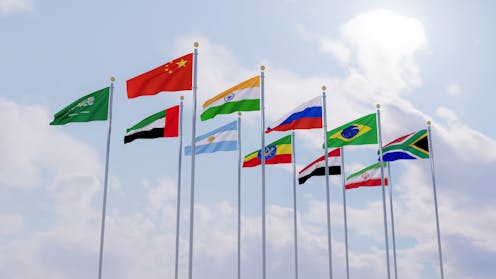Source: The Conversation – (in Spanish) – By Ulf Thoene, Profesor Asociado de Ética Empresarial y Organizacional, Universidad de La Sabana

La cumbre número 17 de los BRICS, que acaba de celebrarse en Río de Janeiro (6 y 7 de julio de 2025), representa un momento crucial para los países emergentes que se han constituido en bloque alternativo al G7, el cual reúne los siete países con mayor peso político, económico y militar a escala global.
El grupo de los BRICS, creado por Brasil, Rusia, India, China y Sudáfrica, cuenta ahora con 10 miembros plenos –dado que persisten dudas sobre la membresía plena de Arabia Saudita, que no ha ratificado su pertenencia– y 10 países socios de diversas regiones del mundo.
BRICS, una fuerza geopolítica global
La Declaración de Río subraya la intención de los BRICS de ir más allá de una plataforma de coordinación económica para convertirse en una fuerza significativa en la geopolítica global. Además, aborda los nuevos y complejos desafíos de seguridad y reafirma su compromiso con un orden mundial multipolar.
Ante los conflictos globales crecientes y la instauración de nuevas políticas comerciales, más proteccionistas (especialmente de EE. UU.), la cumbre resalta la creciente ambición del bloque y su disposición para lograr consensos.
Ausencias destacadas
Ya la cumbre BRICS 2024 (celebrada en Kazán, Rusia) marcó un precedente por su alta participación y una declaración detallada en apoyo del multilateralismo, la cooperación económica y financiera, y los movimientos migratorios entre sus países miembros. Ahora, la presidencia de Brasil prioriza la gobernanza global inclusiva y la colaboración entre naciones en desarrollo.
Sin embargo, han faltado a esta cita dos líderes destacados de los países BRICS: el presidente ruso Vladímir Putin y el presidente chino Xi Jinping. Putin, sobre quien pesa una orden de detención de la Corte Penal Internacional, decidió no asistir por temor a que su avión pudiera ser interceptado. La ausencia de Xi probablemente sea deliberada: Rusia y China dominan el bloque y el líder chino podría haber sido reacio a liderar el encuentro sin la presencia de Putin.
La seguridad como eje central
La Declaración de Río resalta el creciente compromiso de los BRICS con la geopolítica y la seguridad global, una tendencia que ha ido ganando fuerza desde la cumbre de 2022, celebrada en Pekín (China).
Aunque el conflicto en Ucrania recibe menos atención este año, el Medio Oriente y África son preocupaciones principales. Por ello, el presidente brasileño, Luiz Inácio Lula Da Silva, ha propuesto en esta cumbre la reforma del Consejo de Seguridad de Naciones Unidas.
Además, se ha abordado la cuestión del terrorismo con una condena explícita de los ataques en Jammu y Cachemira del pasado abril. La declaración también señala los conflictos en Sudán, Siria y Haití, y hace un llamamiento a la paz y a mantener la acción humanitaria en las zonas en conflicto.
Objetivos económicos y disputas comerciales
A pesar del énfasis puesto en la seguridad global, la misión central de BRICS sigue siendo la coordinación económica y la reforma multilateral. La declaración respalda el desarrollo sostenible, las iniciativas climáticas, la digitalización, la inteligencia artificial, el desarrollo de la ciberseguridad y los programas de desarrollo y ayuda internacional del New Development Bank (NBD).
Sobre el cambio climático, prioridad brasileña, los BRICS rechazan el mecanismo de ajuste de carbono en fronteras aplicado por la UE, al que califican de proteccionista (Artículo 88 de la Declaración de Río).
La declaración expresa la preocupación de los miembros del grupo por las medidas arancelarias unilaterales, que perturban el comercio y contravienen las reglas de la Organización Mundial del Comercio. En cuanto a la discusión sobre la reducción de la dependencia del dólar, los BRICS proponen un sistema de pago propio para disminuir la dependencia de los sistemas financieros occidentales.
Leer más:
New Development Bank, ¿un banco liderado por China para el nuevo orden mundial?
Multipolaridad y gobernanza global
Los BRICS abrazan el multilateralismo y piden reformas para “apoyar las aspiraciones legítimas de los países emergentes y en desarrollo de África, Asia y América Latina, incluyendo los países BRICS, a desempeñar un papel mayor en los asuntos internacionales” y que, en particular, el Consejo de Seguridad de las Naciones Unidas sea “más democrático, representativo, eficaz y eficiente” (Artículo 6).
Este enfoque se alinea con sus críticas a las instituciones nacidas de los Acuerdos de Bretton Woods, como el Banco Mundial y el Fondo Monetario Internacional (FMI), a las que reclama un proceso de reforma para “hacerlas más ágiles, eficaces, confiables, inclusivas, adecuadas a su finalidad, imparciales, responsables y representativas, reforzando su legitimidad” (Artículo 10). Además, defiende iniciativas propias, como el New Development Bank: “reconocemos y apoyamos su creciente papel como un agente robusto y estratégico de desarrollo y modernización en el Sur Global” (Artículo 46).
El presidente brasileño, Lula da Silva, señaló en su intervención que, con el multilateralismo bajo amenaza, está en juego la autonomía de las naciones en desarrollo. .
Desafíos y prioridades estratégicas
Fortalecer instituciones como el New Development Bank y fomentar la cooperación Sur-Sur será crucial para mantener la relevancia de BRICS. Además, su expansión a 20 países, incluyendo miembros plenos como Egipto, Etiopía, Irán, los Emiratos Árabes Unidos e Indonesia, fortalece su influencia global. El bloque representa ya cerca del 50 % de la población mundial, casi el 40 % de su economía en 2023 y más de dos quintas partes de la producción global de petróleo. Sin embargo, este crecimiento complica la construcción de consensos y plantea desafíos sobre la soberanía de los países miembros.
En un mundo volátil, moldeado por guerras comerciales y conflictos regionales, los BRICS enfrentan un equilibrio delicado. El bloque debe tranquilizar a socios occidentales escépticos, como el presidente estadounidense Donald Trump, quien lo ha criticado vehementemente en su red social, Truth Social.
![]()
Ulf Thoene no recibe salario, ni ejerce labores de consultoría, ni posee acciones, ni recibe financiación de ninguna compañía u organización que pueda obtener beneficio de este artículo, y ha declarado carecer de vínculos relevantes más allá del cargo académico citado.
– ref. Cumbre 2025: los BRICS abrazan el multilateralismo y piden reformas en las organizaciones globales – https://theconversation.com/cumbre-2025-los-brics-abrazan-el-multilateralismo-y-piden-reformas-en-las-organizaciones-globales-260573







